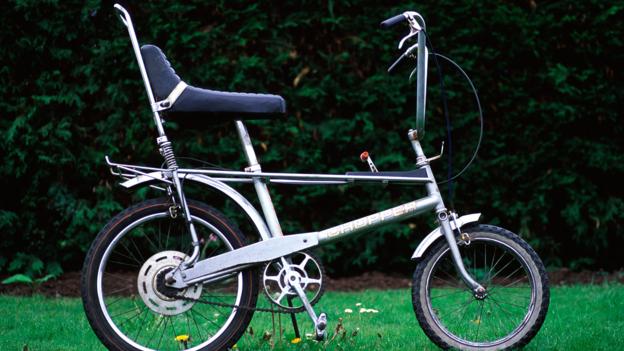A new exhibition at London’s Design Museum celebrates Britain’s love of cycling. Alastair Sooke picks the models that have become modern classics.
As our cities become increasingly overcrowded, more and more people are turning to cycling as a means of beating the traffic while also keeping fit. At the same time, in Britain, the sport of cycling is growing ever more prominent, thanks to the triumphs of high-performance athletes such as Chris Froome, Bradley Wiggins and Chris Hoy.
Last year, British cyclists collectively rode 3.25 billion miles (5.23 billion km) – the highest rate for almost a quarter of a century. To celebrate this boom in cycling, the Design Museum in London is mounting a new exhibition called Cycle Revolution. Rather than a history of bike design since the 19th Century, it’s an investigation into cycling culture today.
The show focuses on four cycling ‘tribes’ selected by the curators – high performers, thrill seekers, urban riders and cargo bikers – and a section devoted to the future of bike design. Here we pick four outstanding bikes that are featured in the exhibition. Inspirational and innovative, they have all quickly established themselves as design classics.
No bike provokes as much nostalgia as the playful Raleigh Chopper, which became one of Britain’s most popular children’s bikes during the 1970s. The original design was based, in part, upon a sketch that the head of Raleigh’s design department, Alan Oakley, made on the back of an envelope during a flight home from the United States. With its high-rise, ‘ape-hanger’ handlebars and a padded saddle incorporating a backrest, it was meant to imitate the kind of American motorbikes ridden by Peter Fonda and Dennis Hopper in the film Easy Rider (1969).
Even though there were concerns about the quality and practicality of the bike’s construction – it was prone to rust, and riding uphill was difficult, thanks to the size of the rear wheel, which was larger than the front one – the Chopper proved to be a phenomenal success. British kids were bewitched by its look, which conferred instant cool upon its riders. By the end of the ‘70s, Raleigh had sold more than 1.5 million Choppers in the UK alone.
Lotus Type 108
On 29 July 1992, Chris Boardman became the first Briton to win an Olympic cycling medal for more than 70 years, after speeding to gold in the final of the 4,000m individual pursuit at the Games held that summer in Barcelona. The bike he was riding, the Lotus Type 108, looked more like a traditional bicycle than an attack aircraft.
Its most revolutionary feature – dreamed up by the self-taught Norfolk engineer and cycling enthusiast Mike Burrows – was its sleek, ‘monocoque’ (or one-piece) black carbon-fibre shell, designed to minimise drag. One of Burrows’ friends was also a keen cyclist who happened to work for the British sports car manufacturer Lotus, based nearby in Norfolk. He took the prototype into the Lotus workshop.
"And it clicked,” Burrows later recalled. "They tested it in their wind tunnel there and said, ‘Hey! What the heck have we got here?’” Lotus decided to invest in the bike, and during the months that ensued, they modified and enhanced its design. When it finally was unveiled on the world stage of the Barcelona Olympics, it was nicknamed the "Superbike” on account of its unforgettable, futuristic appearance – as well as the fact that, while riding it, Boardman smashed the world record twice in the early rounds of the competition, before overtaking his rival on the last lap of the final en route to winning gold.
SplinterBike
Although bicycles were a 19th Century invention, one of the surprising things about their design is that, in a fundamental sense, it hasn’t changed as much as you might think over the past century and a half. "The basic form of the bike is unchanged,” explains Donna Loveday, the curator of Cycle Revolution at the Design Museum. "But while the general form hasn’t changed, the technology and materials have.”
While frames made of steel or carbon fibre are now familiar, one surprising material that many innovative bike designers are drawn towards today is wood: witness the various visionary frames, displayed in the exhibition, built from white ash and beech plywood. The SplinterBike – which was inspired by the Lotus Type 108, and took Norfolk-based wood joiner Mike Thompson 1,000 hours to devise and construct – contains little-used timbers such as the naturally self-lubricating hardwood lignum vitae (which comes in handy for abutting components that turn in opposing directions from one another).
The inspiration for the SplinterBike was a bet with a friend, which galvanised Thompson to create a bike entirely made out of wood. (His mantra became "No bolts or screws, just wood and glues.”) This presented a number of challenges. Unable to use a chain, for instance, he ended up fashioning a gear cog that could transfer power from the pedals to the rear wheel. By 2011, the SplinterBike was complete – and that summer, Thompson’s friend, the amateur cyclist James Tully, rode it to secure the so-called "100 Per Cent Wooden Bicycle Land Speed Record”, achieving an average speed of 11.3mph (18.2kmph).
Brompton prototype
As the populations of cities and conurbations continue to rise – London’s is set to hit nine million by the end of this decade – there is an increasingly urgent need to ease congestion and pressure on public transport networks. One way of doing this is by encouraging urban cycling, which has soared in popularity in recent years thanks to the success of manufacturers specialising in commuter bikes such as the British firm Brompton.
The company was founded by the inventor Andrew Ritchie, who designed his first prototype for a folding bike in his flat overlooking the Brompton Oratory, an imposing Roman Catholic church in London’s South Kensington, in 1975. This, the earliest Brompton prototype in existence, was built in Ritchie’s flat the following year. It already featured several hallmarks of Brompton’s distinctive design, including the pivoting rear triangle, which allows the back wheel to be folded underneath the frame. Ritchie struggled for years to find financial backing for his design. It wasn’t until 1988 that Brompton went into fulltime production, under railway arches in west London.
Today, though, it produces more than 45,000 hand-made bikes every year, making it Britain’s largest bike manufacturer, with sales in 44 countries around the world. It is estimated that there are now more than 80,000 Brompton bikes in London alone.
(BBC)




www.ann.az
Follow us !











